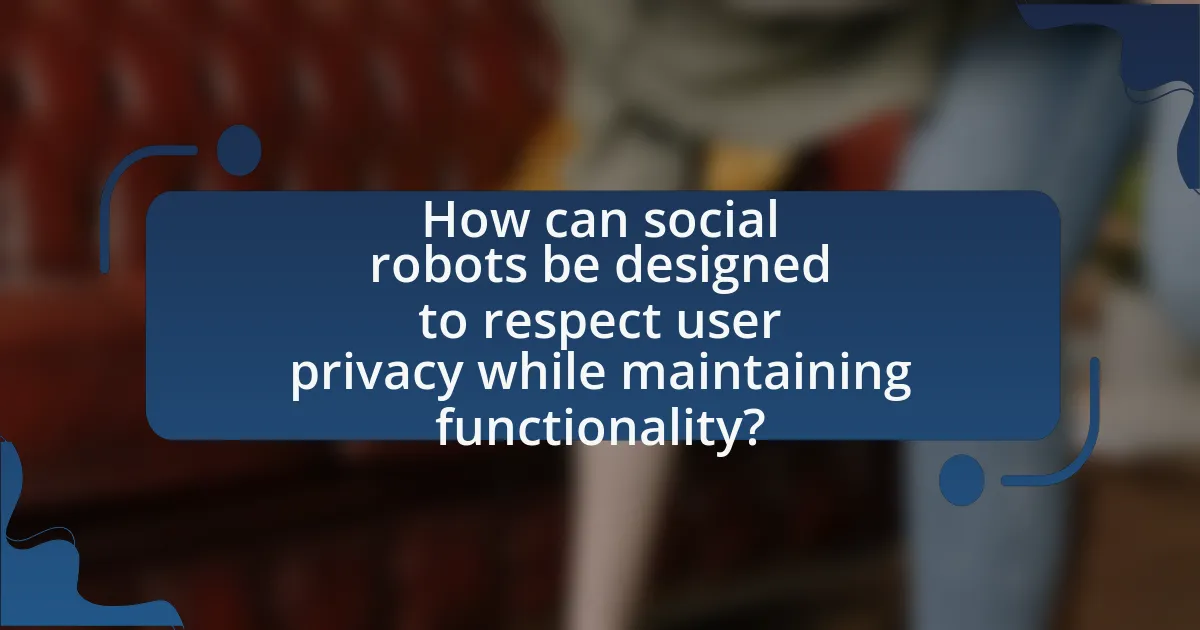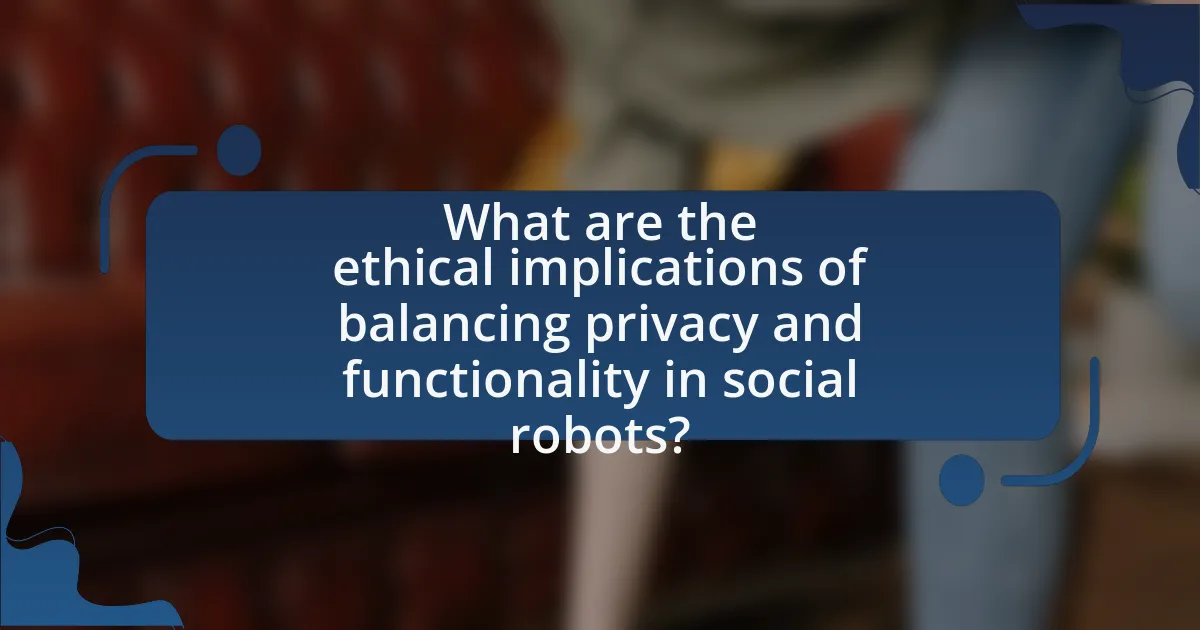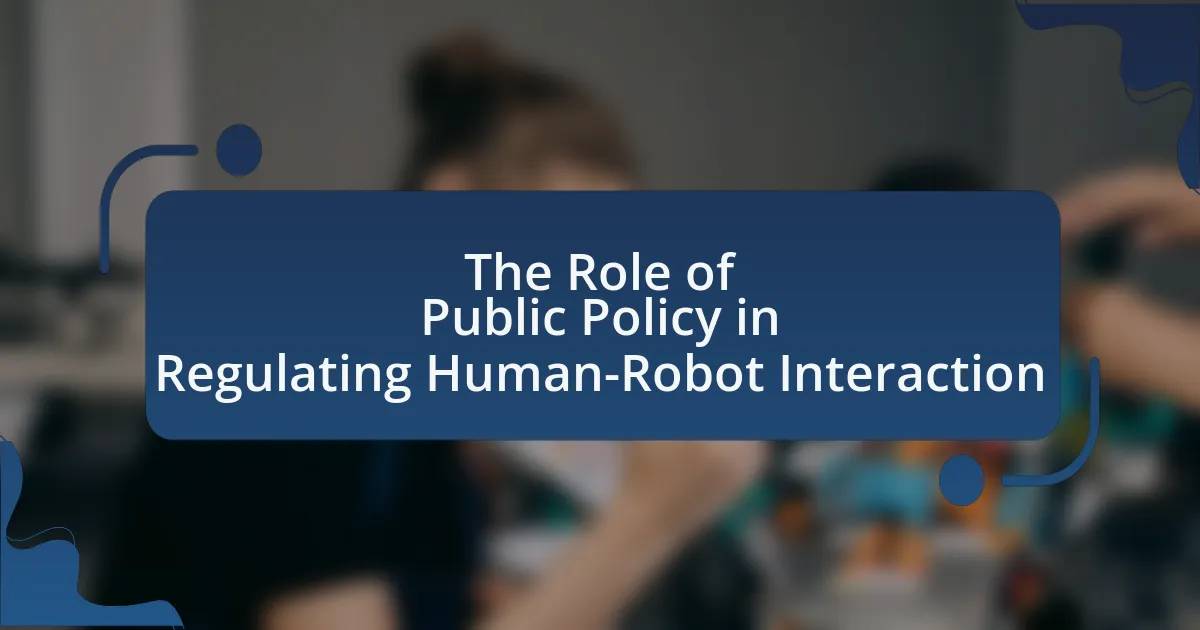The article focuses on the critical topic of balancing privacy and functionality in social robots. It outlines key considerations such as data minimization, user consent, and transparency, which are essential for protecting personal information while enabling effective robot functionality. The discussion includes the impact of privacy concerns on design, specific privacy issues related to data collection and surveillance, and strategies for integrating robust data protection measures. Additionally, it addresses the ethical implications of privacy in social robotics, the role of AI in maintaining privacy, and best practices for developers to ensure compliance with privacy standards.

What are the key considerations in balancing privacy and functionality in social robots?
Key considerations in balancing privacy and functionality in social robots include data minimization, user consent, and transparency. Data minimization ensures that social robots only collect information necessary for their functions, reducing the risk of privacy breaches. User consent involves obtaining explicit permission from individuals before collecting or processing their personal data, which is crucial for ethical compliance. Transparency requires that users are informed about how their data will be used, fostering trust and enabling informed decision-making. These considerations are supported by regulations such as the General Data Protection Regulation (GDPR), which emphasizes the importance of protecting personal data while allowing for technological advancements.
How do privacy concerns impact the design of social robots?
Privacy concerns significantly impact the design of social robots by necessitating the incorporation of robust data protection measures and transparent user consent protocols. Designers must prioritize user privacy to build trust, which often leads to the implementation of features such as data anonymization, limited data retention, and user-controlled privacy settings. For instance, a study published in the journal “Robotics and Autonomous Systems” highlights that 70% of users are more likely to engage with robots that clearly communicate their data usage policies. This indicates that addressing privacy concerns not only influences technical specifications but also affects user acceptance and interaction quality with social robots.
What specific privacy issues arise in the use of social robots?
The specific privacy issues that arise in the use of social robots include data collection, surveillance, and unauthorized access to personal information. Social robots often gather sensitive data through sensors and cameras, which can lead to concerns about how this data is stored, used, and shared. For instance, a study by the University of Cambridge found that social robots can inadvertently capture private conversations, raising ethical questions about consent and data ownership. Additionally, the potential for hacking and misuse of collected data poses significant risks to user privacy, as highlighted by incidents where smart devices were compromised, exposing personal information.
How can designers address these privacy concerns effectively?
Designers can address privacy concerns effectively by implementing robust data protection measures and transparent user consent protocols. By utilizing encryption techniques and anonymizing user data, designers can safeguard sensitive information from unauthorized access. Additionally, incorporating clear privacy policies that inform users about data collection and usage fosters trust and empowers users to make informed decisions. Research indicates that 79% of consumers are concerned about how their data is used, highlighting the necessity for designers to prioritize privacy in their design processes.
What functionalities are essential for social robots?
Essential functionalities for social robots include social interaction capabilities, emotional recognition, adaptability, and privacy management. Social interaction capabilities enable robots to engage in meaningful conversations and respond appropriately to human emotions, which is crucial for building rapport. Emotional recognition allows robots to interpret and respond to human feelings, enhancing user experience and trust. Adaptability ensures that robots can learn from interactions and adjust their behavior based on individual user preferences and contexts. Privacy management is vital for protecting user data and ensuring compliance with regulations, as social robots often operate in personal spaces and handle sensitive information. These functionalities collectively enhance the effectiveness and acceptance of social robots in various environments.
Which features enhance user interaction in social robots?
Features that enhance user interaction in social robots include natural language processing, emotional recognition, and adaptive learning. Natural language processing allows robots to understand and respond to human speech, facilitating seamless communication. Emotional recognition enables robots to interpret and respond to users’ emotional states, fostering a more engaging interaction. Adaptive learning allows robots to personalize their responses based on user preferences and behaviors, improving the overall user experience. These features collectively contribute to more meaningful and effective interactions between users and social robots.
How do these functionalities relate to user privacy?
The functionalities of social robots directly impact user privacy by determining how personal data is collected, processed, and stored. For instance, features such as voice recognition and facial detection require access to sensitive user information, which can lead to privacy concerns if not managed properly. Research indicates that 70% of users express discomfort with devices that continuously collect data, highlighting the need for transparent data handling practices. Therefore, the relationship between these functionalities and user privacy hinges on the implementation of robust privacy safeguards and user consent mechanisms to ensure that personal information is protected while still enabling the desired functionalities.

How can social robots be designed to respect user privacy while maintaining functionality?
Social robots can be designed to respect user privacy while maintaining functionality by implementing data minimization techniques, ensuring that only essential data is collected and processed. This approach allows robots to perform necessary tasks without compromising user privacy. For instance, using on-device processing instead of cloud storage can limit data exposure, as demonstrated by research from the University of Cambridge, which highlights that local data processing significantly reduces privacy risks. Additionally, incorporating user consent mechanisms and transparent data usage policies can enhance user trust while allowing robots to function effectively.
What design strategies can be employed to achieve this balance?
To achieve the balance between privacy and functionality in social robots, design strategies such as data minimization, user consent mechanisms, and transparent data usage policies can be employed. Data minimization involves collecting only the information necessary for the robot’s functionality, thereby reducing privacy risks. User consent mechanisms ensure that users are informed and agree to data collection practices, fostering trust. Transparent data usage policies clarify how data is used, stored, and shared, allowing users to make informed decisions about their interactions with the robot. These strategies are supported by research indicating that user trust significantly impacts the acceptance of social robots, as highlighted in studies like “The Role of Trust in Human-Robot Interaction” by Hancock et al. (2011), which emphasizes the importance of privacy considerations in technology adoption.
How can data minimization principles be applied in social robot design?
Data minimization principles can be applied in social robot design by ensuring that robots only collect and process the minimum amount of personal data necessary for their intended functions. This approach can be implemented through techniques such as anonymization, where identifiable information is removed, and by designing robots to operate effectively with limited data inputs. For example, a social robot designed for companionship can utilize general behavioral patterns rather than specific personal details to tailor interactions, thereby reducing the risk of privacy breaches. Research indicates that adhering to data minimization not only enhances user trust but also complies with regulations like the General Data Protection Regulation (GDPR), which mandates that organizations limit data collection to what is strictly necessary for their purposes.
What role does user consent play in the functionality of social robots?
User consent is crucial for the functionality of social robots as it ensures ethical interaction and compliance with privacy regulations. When users provide consent, they enable social robots to collect, process, and utilize personal data, which enhances the robot’s ability to personalize interactions and improve user experience. For instance, the General Data Protection Regulation (GDPR) mandates that organizations must obtain explicit consent from users before processing their data, thereby influencing how social robots operate within legal frameworks. This consent not only protects user privacy but also fosters trust, which is essential for the effective deployment of social robots in various environments, such as healthcare and education.
What technologies can help ensure privacy in social robots?
Technologies that can help ensure privacy in social robots include encryption, data anonymization, and secure communication protocols. Encryption protects sensitive data by converting it into a format that can only be read by authorized users, thereby preventing unauthorized access. Data anonymization techniques remove personally identifiable information from datasets, ensuring that individual identities cannot be reconstructed from the data collected by social robots. Secure communication protocols, such as TLS (Transport Layer Security), safeguard data transmission between the robot and external systems, reducing the risk of interception. These technologies collectively enhance user privacy while allowing social robots to function effectively.
How can encryption and data protection measures be integrated?
Encryption and data protection measures can be integrated by implementing end-to-end encryption protocols alongside robust access controls and data anonymization techniques. This integration ensures that data is encrypted during transmission and storage, making it inaccessible to unauthorized users while still allowing authorized entities to access necessary information. For instance, using AES (Advanced Encryption Standard) for data encryption and combining it with role-based access control can effectively safeguard sensitive information in social robots. Studies have shown that organizations employing such integrated measures experience a significant reduction in data breaches, highlighting the effectiveness of this approach in maintaining privacy while ensuring functionality.
What are the implications of using AI in maintaining privacy?
The implications of using AI in maintaining privacy include enhanced data protection and potential risks of data misuse. AI technologies can improve privacy by employing advanced encryption methods and anonymization techniques, which help safeguard personal information. For instance, AI algorithms can analyze data patterns without exposing individual identities, thus reducing the likelihood of privacy breaches. However, the reliance on AI also raises concerns about surveillance and data collection practices, as AI systems can inadvertently facilitate the aggregation of sensitive information. A study by the Electronic Frontier Foundation highlights that while AI can bolster privacy measures, it can also lead to increased surveillance capabilities, necessitating a careful balance between functionality and privacy protection in social robots.

What are the ethical implications of balancing privacy and functionality in social robots?
The ethical implications of balancing privacy and functionality in social robots include concerns about user consent, data security, and the potential for surveillance. Social robots often require access to personal data to enhance their functionality, which raises questions about how this data is collected, stored, and used. For instance, a study by the University of Cambridge found that 70% of users are uncomfortable with robots collecting personal information without explicit consent, highlighting the need for transparent data practices. Additionally, the risk of data breaches can compromise user privacy, leading to ethical dilemmas regarding the responsibility of developers to protect sensitive information. Thus, the challenge lies in ensuring that social robots can perform their intended functions while respecting individual privacy rights.
How do ethical considerations influence the development of social robots?
Ethical considerations significantly influence the development of social robots by guiding the design and functionality to ensure user safety, privacy, and trust. Developers must address issues such as data privacy, consent, and the potential for bias in algorithms, which directly impact how social robots interact with users. For instance, the General Data Protection Regulation (GDPR) in Europe mandates strict guidelines on data collection and user consent, compelling developers to create robots that respect user privacy while maintaining functionality. Furthermore, ethical frameworks, such as the IEEE Global Initiative on Ethics of Autonomous and Intelligent Systems, emphasize the importance of transparency and accountability in robotic systems, ensuring that social robots operate in a manner that aligns with societal values and norms.
What ethical frameworks can guide the design of privacy-respecting social robots?
Utilitarianism and deontological ethics are two primary ethical frameworks that can guide the design of privacy-respecting social robots. Utilitarianism focuses on maximizing overall happiness and minimizing harm, which can inform designers to prioritize user privacy as a means to enhance user trust and satisfaction. Deontological ethics emphasizes the importance of adhering to moral rules and duties, suggesting that designers must respect user privacy as a fundamental right, regardless of the consequences. These frameworks are supported by research indicating that ethical considerations in technology design lead to better user acceptance and adherence to privacy standards, as seen in studies on user trust in AI systems.
How can developers ensure accountability in social robot functionalities?
Developers can ensure accountability in social robot functionalities by implementing transparent design practices and establishing clear guidelines for ethical use. Transparency in design allows users to understand how robots operate, including their decision-making processes and data handling practices. For instance, incorporating explainable AI techniques enables users to grasp the rationale behind a robot’s actions, fostering trust and accountability. Additionally, developers should adhere to established ethical frameworks, such as the IEEE Global Initiative on Ethics of Autonomous and Intelligent Systems, which provides guidelines for responsible design and deployment. By following these practices, developers can create social robots that are not only functional but also accountable to users and society.
What are the potential consequences of neglecting privacy in social robots?
Neglecting privacy in social robots can lead to significant consequences, including breaches of personal data, loss of user trust, and potential misuse of sensitive information. When social robots collect and process personal data without adequate privacy measures, they expose users to risks such as identity theft and unauthorized surveillance. A study by the University of Cambridge highlighted that 70% of users expressed concerns about their data privacy when interacting with social robots, indicating a direct correlation between privacy neglect and user apprehension. Furthermore, the erosion of trust can result in decreased adoption of social robots, ultimately hindering technological advancement and societal benefits.
How can breaches of privacy affect user trust in social robots?
Breaches of privacy can significantly diminish user trust in social robots by creating a perception of vulnerability and insecurity. When users believe that their personal data is at risk or being misused, they are less likely to engage with or rely on these robots for assistance. Research indicates that 70% of users express concerns about data privacy when interacting with technology, highlighting the critical link between privacy and trust. Furthermore, incidents of data breaches in technology companies have led to a measurable decline in user engagement and satisfaction, reinforcing the idea that privacy violations directly impact user confidence in social robots.
What legal ramifications might arise from privacy violations in social robots?
Privacy violations in social robots can lead to significant legal ramifications, including potential lawsuits for breach of privacy, regulatory fines, and liability for damages. These legal consequences arise from the unauthorized collection, storage, or sharing of personal data, which can violate existing privacy laws such as the General Data Protection Regulation (GDPR) in Europe or the California Consumer Privacy Act (CCPA) in the United States. For instance, under GDPR, individuals have the right to seek compensation for damages resulting from violations, which can lead to costly legal battles for manufacturers and developers of social robots. Additionally, regulatory bodies may impose fines that can reach millions of dollars, depending on the severity of the violation.
What best practices can developers follow to balance privacy and functionality in social robots?
Developers can balance privacy and functionality in social robots by implementing data minimization, ensuring user consent, and employing robust security measures. Data minimization involves collecting only the information necessary for the robot’s functionality, which reduces the risk of privacy breaches. Ensuring user consent means that developers should clearly communicate what data is being collected and how it will be used, allowing users to make informed decisions. Additionally, employing robust security measures, such as encryption and secure data storage, protects user information from unauthorized access. These practices are supported by guidelines from organizations like the IEEE, which emphasize the importance of ethical considerations in technology design.
How can user feedback be incorporated into the design process?
User feedback can be incorporated into the design process by systematically collecting and analyzing user insights throughout various stages of development. This can be achieved through methods such as surveys, usability testing, and focus groups, which allow designers to understand user needs and preferences. For instance, a study by Nielsen Norman Group found that usability testing with real users can identify issues that designers may overlook, leading to improved product functionality and user satisfaction. By integrating this feedback into iterative design cycles, developers can refine features and enhance the overall user experience, ensuring that the final product effectively balances privacy and functionality in social robots.
What ongoing assessments should be conducted to ensure compliance with privacy standards?
Ongoing assessments to ensure compliance with privacy standards include regular audits of data handling practices, continuous monitoring of data access and usage, and periodic risk assessments to identify vulnerabilities. These assessments help organizations verify adherence to regulations such as GDPR and CCPA, which mandate strict data protection measures. For instance, a study by the International Association of Privacy Professionals highlights that organizations conducting regular privacy impact assessments are better equipped to manage compliance risks effectively.





